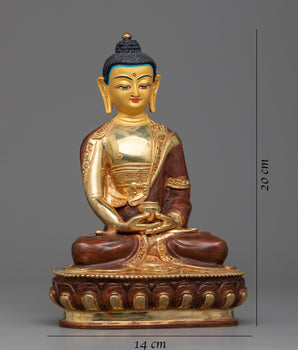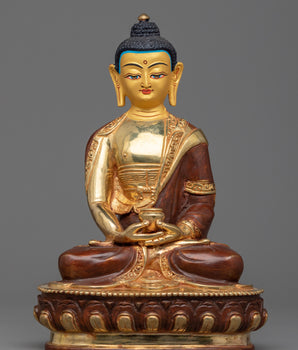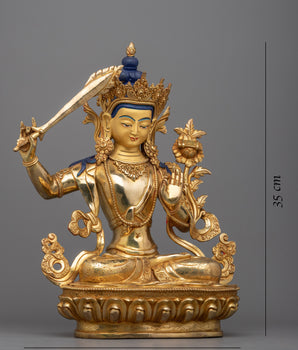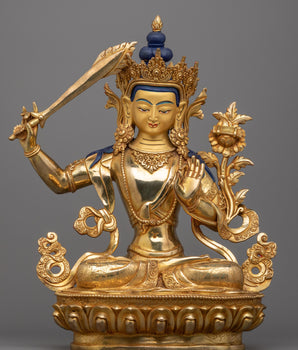Nestled between rugged peaks, Himalayan art and artefacts carry layers of meaning—material, symbolic, spiritual. Among the precious materials that figure prominently, lapis lazuli stands out. Not merely beautiful, it bridges geology, history, ritual, and aesthetics. Let’s explore what lapis lazuli is, its properties, its traditional and symbolic uses, and specifically how it features in Himalayan artefacts. Lapis Lazuli Amitayus Statue: Buddhist Handmade Statue
Lapis Lazuli Amitayus Statue: Buddhist Handmade Statue
What is Lapis Lazuli? Origins and Physical Properties
To understand its significance in Himalayan art, we first need to know what lapis lazuli is, where it comes from, and what physical properties make it distinctive.
-
Composition: Lapis lazuli is a metamorphic rock whose chief jewel component is lazurite; but it also commonly includes pyrite (which give gold-like specks), calcite (white streaks or patches), sometimes sodalite and other minerals.
-
Colour, texture, hardness: Its most prized hue is a deep, saturated blue ("royal blue," sometimes ultramarine), often with visible flecks of pyrite (which can look like stars) and occasional white calcite streaks. The hardness is moderate, which means while it is fairly durable, it can be scratched and needs care.

Lapis Lazuli Buddha Shakyamuni Statue
Its Symbolic, Cultural & Spiritual Meanings
Beyond its physical beauty, lapis lazuli carries a rich array of symbolic and spiritual meanings — this is where its resonance in Himalayan artefacts becomes particularly profound.
-
Wisdom, Truth, Inner Vision
Many sources attribute to lapis the ability to sharpen intellect, to help one see truth, to open the “third eye” (in yogic or tantric cosmologies) or otherwise heighten inner vision. -
Royalty, Prestige, Power
Historically, lapis lazuli was considered a stone of kings and queens. Due to its rarity, deep colour, and the effort needed to obtain and work it, lapis becomes a marker of status. -
Spiritual / Healing Use
In many belief systems, lapis lazuli is believed to have healing properties (physical, emotional, psychic). It is also used in meditation, ritual objects, as a protective or spiritually clarifying material. -
Legend, Myth, Translation & Language
The name itself carries meaning: “lapis” (Latin) = stone; “lazuli” (from Persian “lāzward”) = sky or heavens. The stone is often associated with the heavens, celestial sky, or with light in darkness.
There are stories in Tibetan contexts about translating terms for lapis lazuli— suggesting its importance linguistically and culturally in Himalayan Buddhist scholarship.
Himalayan Artefacts: How & Where Lapis Lazuli is Employed
Given its material beauty and spiritual symbolism, lapis lazuli finds a central role in Himalayan art and artefacts. Here are some of the key ways it was employed and the meanings it carried:
-
Ritual Statues and Icons
Lapis lazuli are often inlaid into the crowns, halos, eyes, and jewellery of Buddhas, bodhisattvas, and other deities. Sometimes it appeared in the base or surrounding decorative elements of statues. Its deep blue colour suggested transcendence and divine light, while pyrite flecks within the stone created a sparkling “heavenly” effect. By embedding such a rare stone, artisans emphasized devotion, reverence, and the wealth of the patron who commissioned the piece. -
Thangkas and Painting
Although lapis lazuli pigment (ultramarine) was not always directly sourced from the stone itself, its colour inspired many mineral-based paints. In Tibetan thangka paintings, deep blues derived from lapis or similar minerals were highly prized. These shades were often used for cosmic backgrounds, skies, or to depict deities like the Medicine Buddha. The colour signified space, the void, and purity — all central concepts in Buddhist cosmology. -
Jewellery and Ceremonial Dress
Himalayan Handmade Teapot with Lapis Lazuli
Lapis was also incorporated into crowns, necklaces, and ritual jewellery worn by priests or aristocrats. In Ladakh, for example, the perak headdress was adorned with lapis alongside turquoise and other stones. Beyond ornamentation, such jewellery carried protective and spiritual symbolism. The bold blue made a powerful impression, marking status and sanctity in equal measure.
-
Architectural Decoration and Ritual Objects
In temples and monasteries, lapis lazuli was sometimes used as inlay in shrines, offering bowls, reliquaries, or decorative panels. Its striking colour was also echoed in architectural elements, drawing the eye to sacred spaces. The deep blue often complemented gold, creating a luminous and regal aesthetic that reinforced the sanctity of the building or object. -
Manuscripts, Texts, and Translations
Though less often present as the stone itself, lapis lazuli made its way into the textual and metaphorical realm. Ancient Tibetan translations and scriptures referenced lapis to describe clarity, brilliance, or the celestial quality of wisdom. In this sense, even when not physically embedded, lapis lazuli coloured the spiritual imagination of Himalayan scholars and practitioners.
Connections: Lapis-Linked Deity & Ritual Uses in the Himalayas
One of the richest connections is with the Medicine Buddha (Bhaiṣajyaguru) — often called the “Blue Medicine Buddha”, because he is said to emit the light of healing likened to lapis lazuli (“vaiḍūrya-prabha” — “lapis lazuli light”). The colour blue in his iconography is not just aesthetic, but central to the mythic and ritual meanings. It refers to his pure healing power, removal of suffering, and spiritual purification. This makes lapis lazuli especially appropriate in artefacts dedicated to him.  Similarly, objects used in healing or purification rituals might use lapis (or blue stones inspired by lapis) for their symbolic potency.
Similarly, objects used in healing or purification rituals might use lapis (or blue stones inspired by lapis) for their symbolic potency.
Care, Authenticity, and Variation
Since lapis is so valued, there are issues around authenticity, quality, and preservation.
-
Authenticity & Imitations: Because lapis lazuli has become popular, dyed stones or treated stones/imitations are common. Looking for natural inclusions, consistent weight, genuine colouring helps.
-
Variation among sources: Lapis from Afghanistan tends to have deeper, richer blue and more desirable pyrite speckles; sources like Chile may produce lighter blues, with fewer inclusions. The provenance often affects both price and cultural value.
-
Care / Conservation: Because lapis is not extremely hard, care is needed: avoiding harsh chemicals, extreme heat, strong sunlight (which may fade colour), physical abrasion. For artefacts, this means controlled humidity, careful cleaning, and avoiding damage to stone inlays.
Why Lapis Lazuli Matters in the Himalayan Context
Putting all of this together, why is lapis lazuli especially significant in Himalayan art and artefacts?
-
Geographical & Trade Connections
The Himalayas lie not far from major historical trade corridors (e.g. via Badakhshan), so high-quality lapis’d reach Himalayan regions such as Tibet, Nepal, Ladakh, Bhutan etc. This made it accessible among religious elites. Also, cultural exchange meant its symbolic value traveled. -
Colour symbolism aligned with Buddhist cosmology
In many Himalayan Buddhist iconographic traditions, blue is associated with space, the sky, the void, with certain deities (especially healing ones). It suggests depth, meditative stillness, transcendence. Lapis provides a material proxy for that symbolism. -
Expressing Sacredness in Material Form
Himalayan artefacts are not just art: they are ritual tools, embodiments of belief. Using something as rare and beautiful as lapis lazuli helps to articulate reverence, devotion, sanctity. It turns an object from “beautiful” into “sacred”. -
Enduring aesthetic & cultural legacy
As styles evolve, lapis remains respected—its deep blue remains attractive, its symbolic associations remain strong. Whether in statuary, jewellery, or ritual paraphernalia, lapis adds a layer of continuity with tradition.
Use of Imitation Lapis Lazuli in Himalayan Jewellery
While natural lapis lazuli has always been prized, in the Himalayan regions its imitation has also played a role, especially in jewellery and ornaments. Traders and artisans sometimes substituted more readily available blue stones (like dyed quartz, glass, or lower-grade calcite with pigment) for true lapis. 
-
Accessibility: Genuine lapis, imported from mines in Afghanistan, was expensive. To make similar jewellery affordable to a wider range of people, artisans used imitations that mimicked the deep blue look. This meant that the aesthetic and symbolic value of “blue stone” could be enjoyed by those outside aristocratic or monastic elites.
-
Cultural Continuity: Even when imitations were used, the symbolic association of blue stone with spiritual power, protection, and prestige remained intact. For example, a Ladakhi perak headdress might mix true lapis with turquoise and imitation stones to create the striking layered effect, while still conveying social rank.

-
Modern Markets: Today, many “Himalayan lapis” ornaments sold in bazaars or tourist markets rely heavily on imitation stones or reconstituted lapis (lapis powder mixed with resin). These serve as affordable cultural souvenirs, but they also continue a long tradition of substituting materials while retaining cultural meaning.
In short, while imitation stones lack the geological and monetary value of authentic lapis lazuli, they play an important role in sustaining the symbolic resonance of the stone within Himalayan communities.
Lapis lazuli is more than ornamental in Himalayan artefacts. It embodies a confluence of geology, trade, spiritual ideology, ritual practice, and aesthetics. Its great blue colour isn’t just a colour — it is a signal: of the otherworldly, of the sacred, of knowledge, of healing. In every inlaid crown, carved halo, or deity image studded with lapis, there’s a story: of human aspiration to touch the infinite.
If you visit a Himalayan temple or museum and see artefacts with lapis lazuli, you can now read them more deeply: not just beautiful objects, but words in stone, symbols in lapis.

















